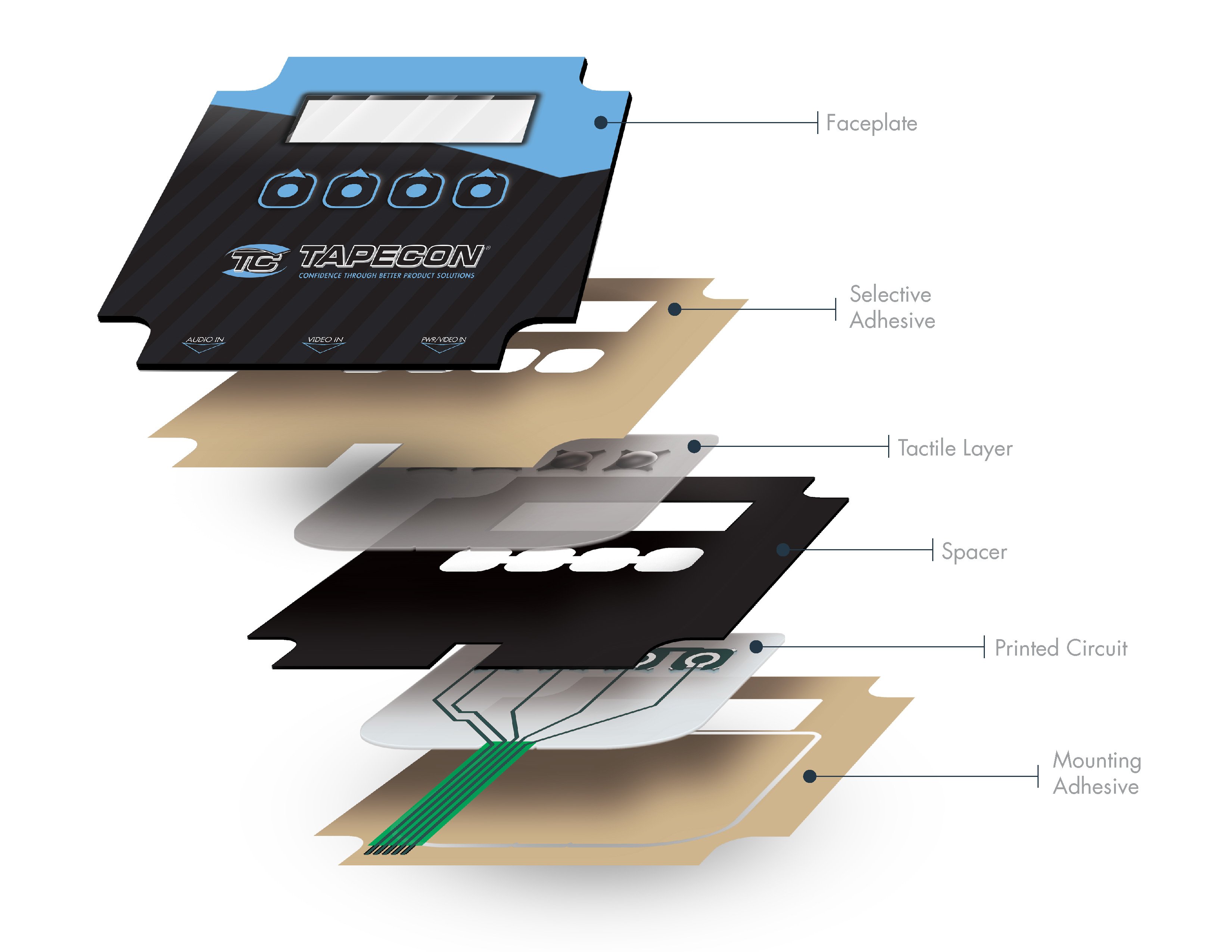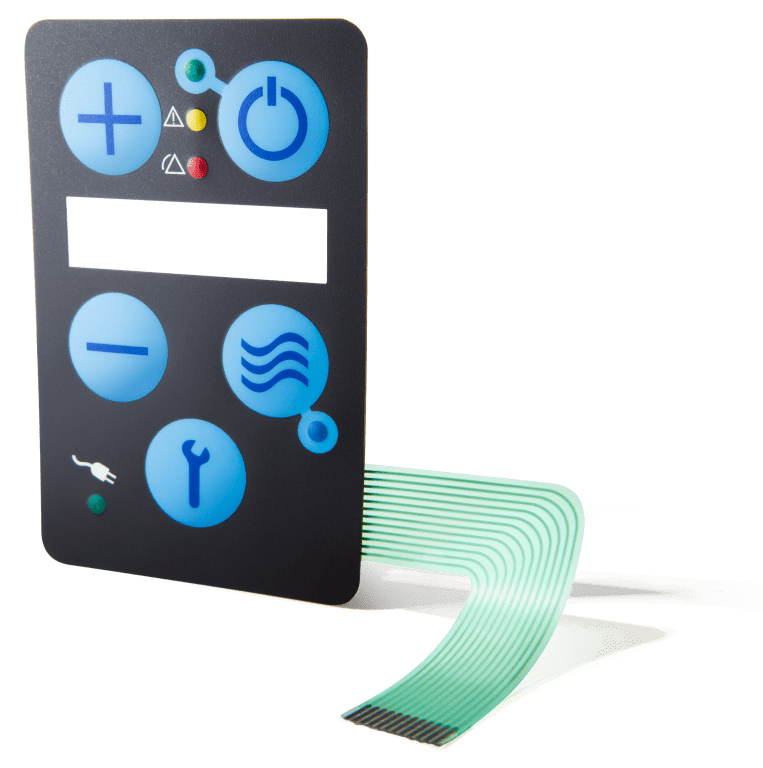Recognizing the Value of Membrane Switches in Individual Interfaces
Membrane switches are indispensable elements in the design of effective interface, helping with not only capability however also boosting aesthetic allure and individual communication. Their special features, such as resistance to environmental variables and adjustable designs, make them appropriate for a diverse variety of applications across numerous industries. As we discover the various benefits and future fads linked with Membrane technology, it ends up being clear that these buttons are greater than simply components; they represent a convergence of technology and functionality. The implications of this innovation on individual experience deserve analyzing additionally.
What Are Membrane Switches?

The spacer layer, which contains glue buildings, enables the separation of the circuit layer from the overlay, ensuring that the button remains in a non-activated state up until pressed. When pressure is put on the overlay, it compresses the spacer layer, linking the space and completing the circuit in the underlying layer. This design not just minimizes the physical area required for typical mechanical buttons but additionally boosts the sturdiness of the device, as Membrane switches are generally immune to dust, dampness, and various other ecological variables.
Frequently discovered in applications ranging from consumer electronic devices to clinical tools, Membrane buttons are indispensable to modern innovation, offering a straightforward and effective interface that aligns with modern style demands.
Advantages of Membrane Switches
While countless switch technologies exist, Membrane Switches deal unique benefits that make them particularly preferable in numerous applications. One of the key benefits of Membrane buttons is their compact style, which enables space-saving applications in tools where property is limited. Their slim profile not only boosts aesthetic charm however also helps with light-weight construction.
One more substantial advantage is their resistance to environmental aspects. Membrane switches are usually secured versus moisture, dust, and pollutants, making them excellent for use in demanding atmospheres, such as clinical devices and industrial tools. This longevity prolongs the life-span of the switch, reducing upkeep costs and boosting integrity.
Furthermore, Membrane buttons can be customized to meet details layout needs, integrating one-of-a-kind graphics and colors that improve customer communication. Their tactile feedback choices can additionally be tailored to provide a rewarding customer experience. In addition, Membrane buttons are cost-efficient, specifically in high-volume applications, as they can be created successfully.
Applications in Different Industries

In the customer electronics sector, Membrane switches prevail in tools such as microwaves, washing machines, and remotes. Their responsive comments and visual choices enhance customer click to investigate experience while offering a sleek, contemporary look. In addition, automobile manufacturers make use of Membrane switches in control panel controls and infomercial systems, where area is limited, and user engagement is important.
Additionally, the industrial field leverages Membrane switches in control panels for machinery and equipment, permitting instinctive procedure in typically harsh settings. Their resistance to chemicals and dampness makes certain durability and reliability in these applications. Generally, the flexibility of Membrane Switches contributes significantly to their prevalent use, making them essential in numerous technical domain names.
Design Considerations for Membrane Switches

When creating Membrane buttons, numerous crucial considerations should be considered to guarantee optimal capability and individual experience. The option of products is vital; picking resilient, high-quality substrates can improve the button's long life and resistance to ecological elements such as wetness and temperature level variations.
Second of all, the layout of the visuals overlay need to prioritize clarity and ease of usage. Symbols and text need address to be understandable, and the format needs to facilitate intuitive communication (membrane switches). In addition, responsive comments is necessary; integrating a tactile dome or various other devices can improve the user experience by providing physical verification of activation
One more essential factor is the button's electrical efficiency. Designers have to make sure that the conductive traces are effectively made to lessen resistance and avoid signal disturbance. This entails examining the required actuation force and ensuring compatibility with the electronic parts they will interface with.

Future Patterns in Membrane Innovation
As modern technology continues to advance, Membrane switches are poised to advance significantly, driven by technologies in products and producing methods. One emerging trend is the unification of advanced products, such as conductive inks weblink and flexible substrates, which improve longevity and reduce the general weight of Membrane buttons. These products not just improve the tactile reaction however also permit for the layout of switches that can stand up to harsher ecological conditions.
Moreover, the assimilation of touch-sensitive modern technologies is transforming traditional Membrane Switches into more interactive customer interfaces. Capacitive touch sensing units installed within Membrane button panels can provide a much more instinctive and responsive customer experience, straightening with the expanding need for streamlined, modern-day layouts in customer electronic devices.
Additionally, developments in printing methods, such as digital and 3D printing, allow quick prototyping and personalization of Membrane buttons. This versatility enables producers to respond quicker to market demands and consumer choices.
Lastly, sustainability is coming to be a significant focus, with manufacturers exploring eco-friendly materials and procedures. As these patterns unravel, the future of Membrane technology promises enhanced capability, visual charm, and environmental obligation, solidifying their duty in innovative customer interfaces across different industries.
Conclusion
To conclude, Membrane Switches stand for a crucial component in the style of interface, combining capability with aesthetic versatility. Their advantages, consisting of toughness and resistance to environmental variables, make them appropriate for diverse applications throughout various sectors. Thoughtful style factors to consider improve user communication and experience. As improvements in innovation proceed, the development of Membrane switches is anticipated to further improve user interfaces, driving technology and improving functionality in a progressively complex technical landscape.
Membrane switches are indispensable components in the style of efficient individual interfaces, facilitating not just functionality but likewise boosting aesthetic charm and individual communication.Membrane Switches serve as an essential component in various individual interfaces, promoting a seamless interaction between individuals and electronic gadgets.While countless button technologies exist, Membrane Switches offer distinct advantages that make them especially preferable in various applications.Furthermore, Membrane buttons can be personalized to satisfy particular layout requirements, incorporating distinct graphics and colors that enhance user interaction.In conclusion, Membrane Switches stand for an essential part in the layout of customer interfaces, incorporating functionality with visual versatility.
Comments on “Choosing the Right Membrane Switches for Your Product’s Needs”